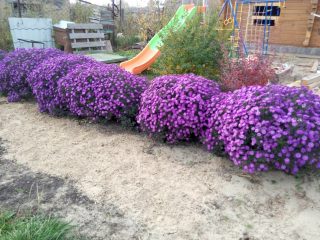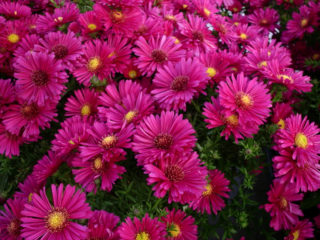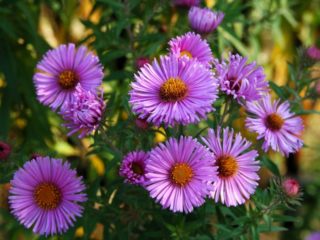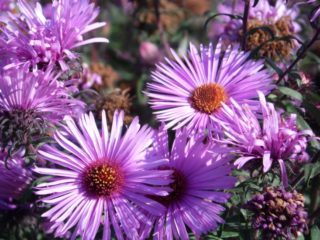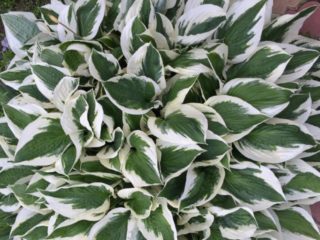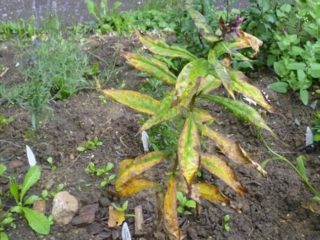Content
Aster heather is a perennial that is very popular in the USA and Canada, it grows freely in nature. In Russia, the flower is not common. The plant is appreciated by gardeners for its decorative appearance, frost resistance and unpretentiousness.
Description of groundcover heather aster
The plant belongs to the Asteraceae family. The culture is characterized by strong, well-branched shoots, reaching 70-100 cm in height. Outwardly, the flower resembles a shaggy shrub.
The upper leaf plates of the heather aster are small in size, up to 1-1.5 cm in length, needle-shaped, arranged alternately. Their color is dark green. The lower leaf plates grow up to 6 cm in length, spatulate.
Most varieties of perennial ground cover heather aster bloom throughout the fall: from September to November. The buds have a pleasant aroma and varied colors: light purple, white or blue with a brown center.
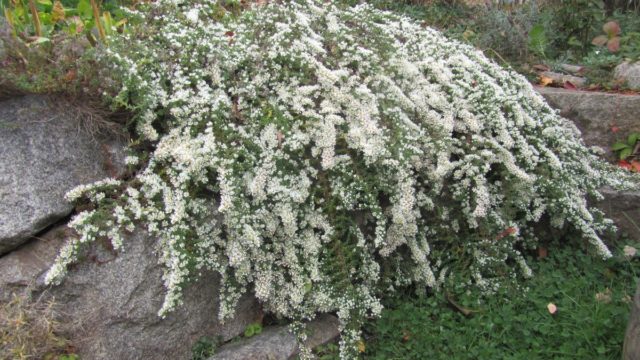
The wild-growing aster has small flowers, white or pinkish.
The family is characterized not only by frost resistance, but also by the ability to withstand temperature fluctuations. Plants are not afraid of spring frosts, periods of drought.
The culture is characterized by rapid expansion in width, which requires the construction of a constraint. If the branches are not tied up, they gradually slope downward. Young shrubs are spherical. Designers use this characteristic feature to create various landscape compositions from bush.
After the end of flowering, flat-shaped seeds are formed. Since the buds of the heather aster are formed in the autumn months, the seed does not have time to ripen. This characteristic forces gardeners to abandon the propagation of asters with heather seeds.
Varieties of creeping heather asters
The plant began to be cultivated in 1732. Breeders have developed many hybrids that differ in the color of the buds and the size of the shrub. The principles of planting and caring for varieties of small-flowered heather asters are similar.
Pink Clou
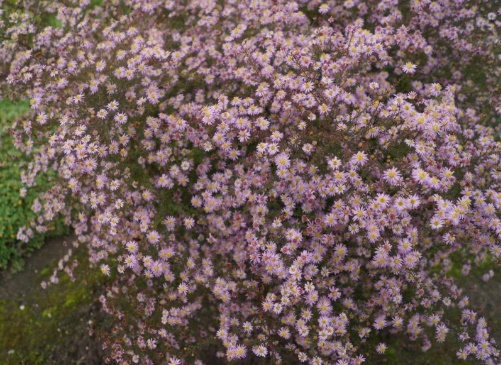
The flower retains its decorative properties throughout the summer and autumn months.
The shrub grows up to 30-40 cm in height, has a spherical shape. During the flowering period, it is strewn with small buds of a white-pink hue.
Herbstmyrthe
The hybrid grows more than 1 m in height, it is a beautiful spreading shrub. Inflorescences are collected from small buds of white color with a lilac tint. Their size does not exceed 10-12 mm in diameter. The middle of the flowers is yellow.
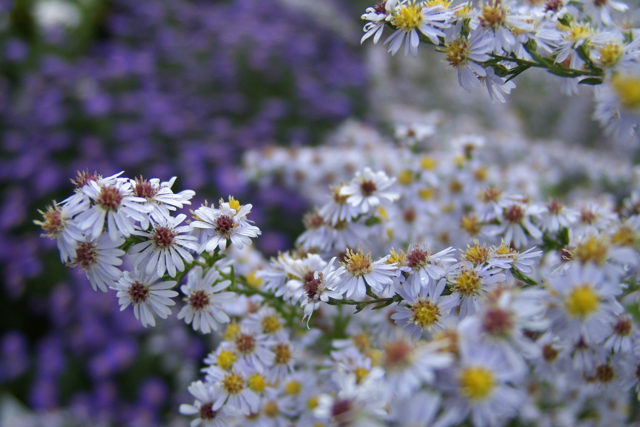
The blooming period of the heather aster is 1.5 months, the first buds are formed at the beginning of September
Snow flurry
The heather aster shrub is undersized: no more than 10 cm in height. The plant grows rapidly on the soil, covered with white buds so densely that the flower is outwardly covered with a snow-white blanket. Flowering lasts from September to November.
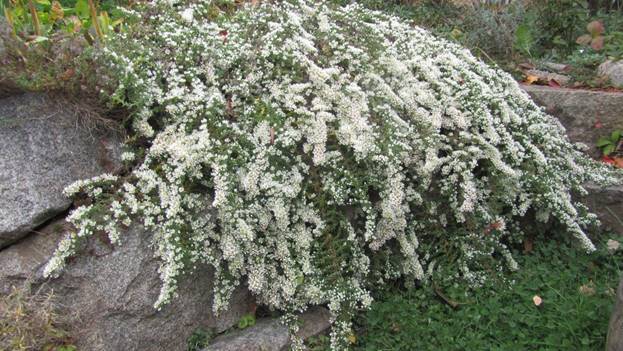
Often landscape designers prefer to plant aster heather on rocky hills so that the branches descend beautifully, resembling an avalanche
Blue Star
This variety of heather aster looks unusual: a shrub of medium height, up to 70 cm in length, has squat branches with needle-like leaf plates. Outwardly, the plant looks like heather or dwarf ephedra. Inflorescences appear in September and wither at the end of October. The color of the buds of a heather ground cover aster is pale blue with a purple tint and a yellow core. Often the photo does not convey the beauty of the shade of the variety.
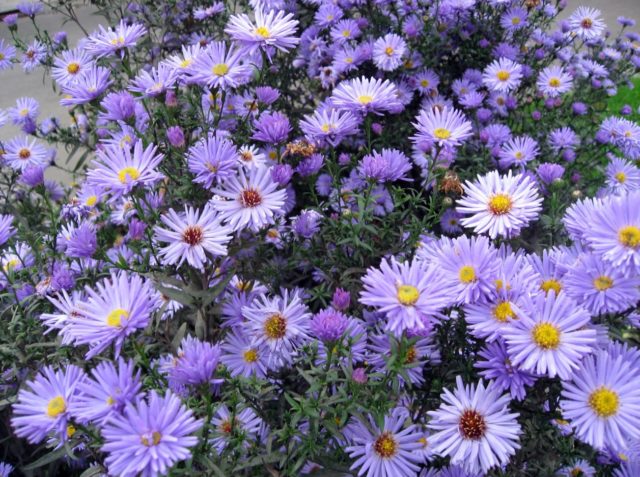
Aster heather is suitable for single planting on the site or in groups, but gardeners grow the plant in containers
Lady in Black
Small-flowered autumn aster reaches 120 cm in height. Under the weight of the flowers, the branches fall to the ground, so the plant looks like a ground cover. The color of the buds is milky white, the core is pinkish brown.
Heather aster has good immunity, is not afraid of pests. Prefers sunny areas.
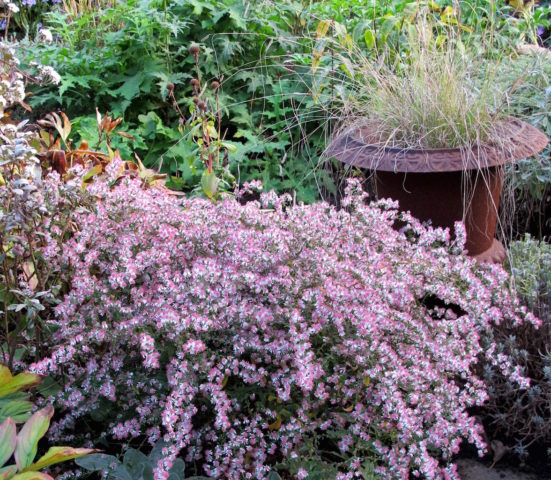
The variety looks great in a composition with astilba, Bonnard verbena, bright daffodils or tulips
The variety looks great in a composition with astilba, Bonnard verbena, bright daffodils or tulips
Golden Spray
Heather aster branched, reaches a height of 80-100 cm. The leaf plates are linear, arranged alternately. Aster inflorescences are formed from September to October. The bud does not exceed 1 cm in diameter. The flowers are white, but with a bright golden core.
During the planting of ground cover heather asters, they try to place other drought-resistant crops next to them: liatris or solidago, so that the group will delight with flowering until late autumn.
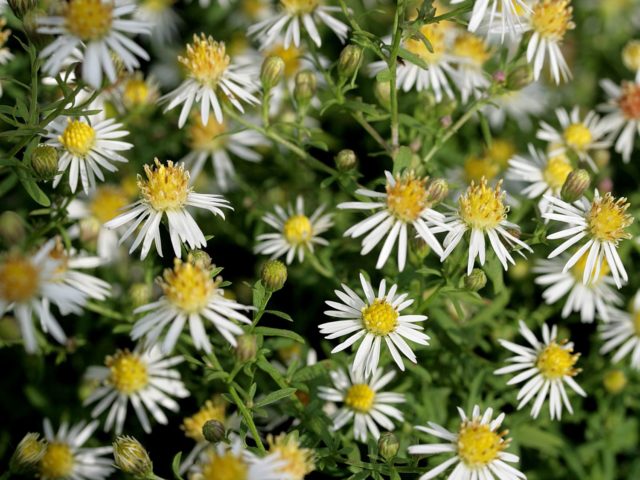
Variety Golden Splash is frost-hardy, prefers sunny places and fertile soils
Reproduction of ground cover heather aster
Despite the fact that the plant can be propagated by seeds, this method is rarely used: it is difficult to collect seed due to the peculiarities of flowering.
If this method is suitable for the gardener, then you should use one of the options:
- before the first frost, gently tear off the aster inflorescence and spread it in a thin layer on a sheet of paper on the windowsill;
- in the fall, dig out the bush and transplant it into a pot, and then bring it home, where to provide it with lighting and a temperature of 18-20 ° C.
These methods of obtaining seeds are imperfect: the material has a low level of germination.
You can get good crops if you collect the seeds as follows: pick the buds 50-60 days after the beginning of flowering, dry, then collect the material. But this method is practically impossible: frosts will not allow the seeds to ripen.
More often, gardeners give preference to breeding asters heather by dividing or planting cuttings.
The procedure is carried out in the fall according to the following algorithm:
- Dig up the rhizome.
- Divide it into several parts, preserving the integrity of the root system as much as possible.
- Place the shares in the prepared holes and cover with soil, water.
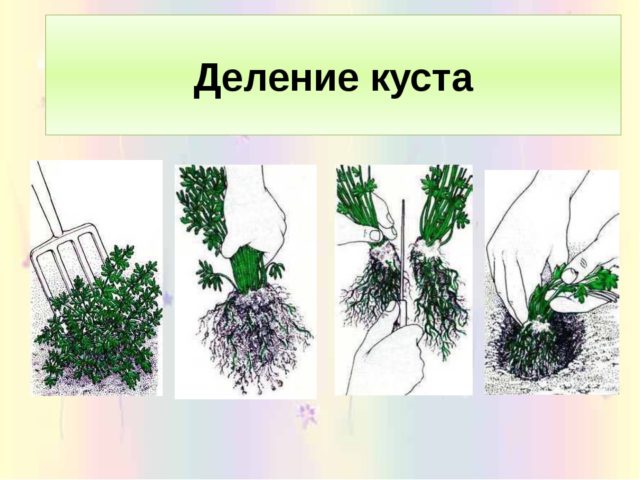
If, when dividing the plant, damage the roots or separate the share with a weak rhizome, then the heather aster may not take root
To increase the shrub's chances of survival, it is recommended to cover it for the winter, since a weakened flower may not withstand frosts.
The propagation process by cuttings is long: the green shoot is rooted in June, having previously processed it with Kornevin. To do this, it is placed in soil and covered with a plastic bottle.
Within 30 days, the stalk of a heather aster should take root. After that, it should be periodically ventilated throughout the winter to get used to the ambient temperature. In the spring, the cutting is transferred to open ground. Flowering will be in the second year.
Application in landscape design
Ground cover is a plant trait for which landscape designers are ready to forgive the aster for late flowering. It is used for landscaping areas, parks and gardens. The shrub spreads beautifully along the ground, looks decorative even before flowering.
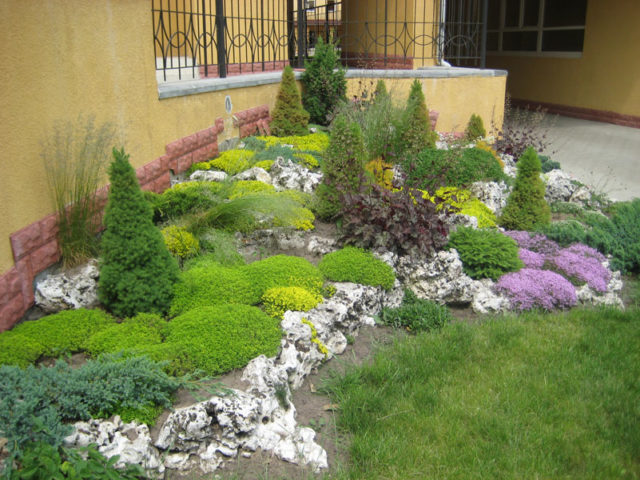
Low-growing varieties of heather asters go well in group compositions on flower beds with representatives of conifers, as well as irises, carnations
Tall hybrids are preferably planted close to rudbeckia or ornamental yarrow.

Heather asters also look worthy in single plantings: it is preferable to place shrubs in flowerpots or plant along the paths
Planting and caring for ground cover heather aster
All varieties have similar planting principles: sowing seeds, transplanting into open ground. The abundance of flowering of the shrub and the duration of its life depend on compliance with the rules of agricultural technology and the choice of location.
Timing
If it is decided to use the seedling method, then the seeds are sown in February-March. If the material is planned to be planted immediately in open ground, then the timing is adjusted: the procedure is carried out in May or late autumn, before the onset of frost.
Site selection and soil preparation
In the shade, the plant weakens and is attacked by pests and diseases. More abundant flowering in varieties planted in a place open to sunlight.
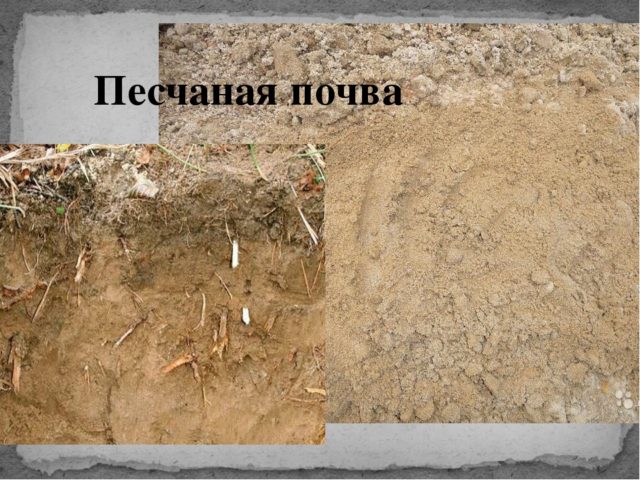
Aster heather grows safely on sandy or clay soil
The soil is prepared in the fall, dug up, mineral fertilizers are applied - potassium salt, superphosphate.
In the spring, the soil under the bed for the heather aster is loosened, weeds are removed, and thoroughly shed.
Landing algorithm
Seeds should be planted in open ground as follows:
- form a bed;
- deepen the seeds 1 cm into the ground;
- water the soil;
- mulch the bed, spreading compost over the surface with a thin layer.
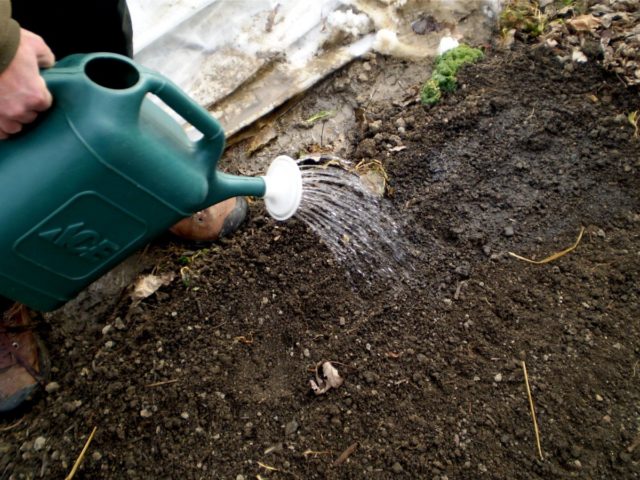
If the soil is moistened in a timely manner, then the shoots of the heather aster appear on the 8-10th day.
When the sprouts get stronger, thinning is carried out, keeping a distance of 15 cm between the specimens.
If planting is required in the fall, then the material is sown into frozen soil, covered with a layer of compost on top. Seedlings will appear in the spring.
Follow-up care for heather aster
The shrub is unpretentious. In one place, it is able to grow and bloom profusely for 5 years.
Care principles:
- regular but moderate watering;
- feeding three times per season, in spring, when buds appear and after flowering (mineral and organic flower mixtures);
- loosening the soil and removing weeds;
- timely removal of wilted buds and leaf plates.
Since the heather aster is frost-resistant, it does not need shelter. Preparation for the winter period consists in pruning the aboveground part of the shrub.
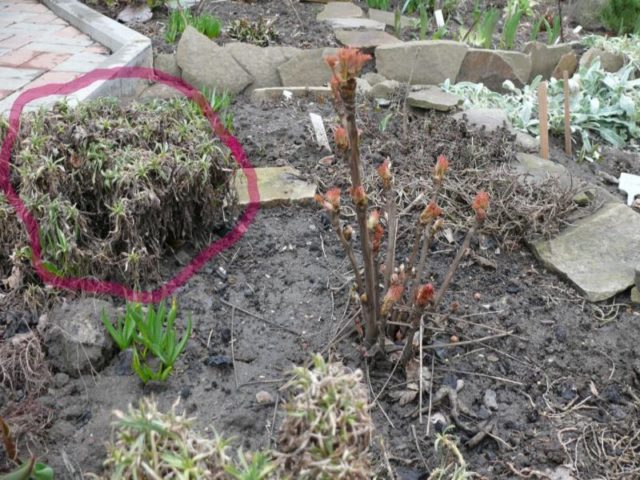
The shoots of the plant should protrude 20-30 cm in height above the ground
Pests and diseases
Perennial has strong immunity. It can only be weakened by poor care or climate, prolonged rains or other disasters.
Nematodes and spider mites are capable of harming aster heather. To destroy them, the plant is irrigated with an insecticide solution: Actellik, Akarin, Phytochit, Chloropikrin, Neoron.
Heather aster growing in the shade is more often attacked by fungal pathogens. One of them is powdery mildew.
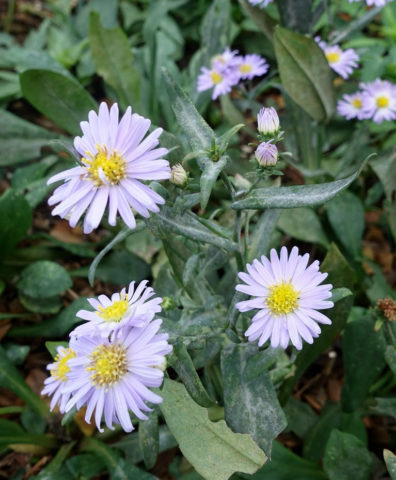
When a white bloom appears on the leaf plates, the shrub should be treated with copper sulfate
Rust can move from coniferous crops to heather aster. To determine it, you need to examine the underside of the plant's leaf: it will have brown pustules. Gradually, the leaves curl and fall off.
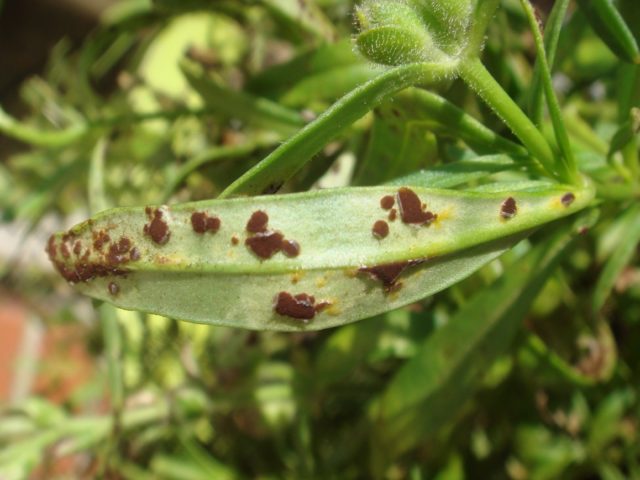
As a therapeutic measure, all affected parts of the shrub should be removed, the plant itself should be irrigated with fungicides, and the soil around should be shed with a solution of the drug.
Among serious diseases, asters heather gray rot can affect. To determine it, they inspect the plant, it changes color to brown, begins to rot and becomes covered with a bloom of a smoky hue.
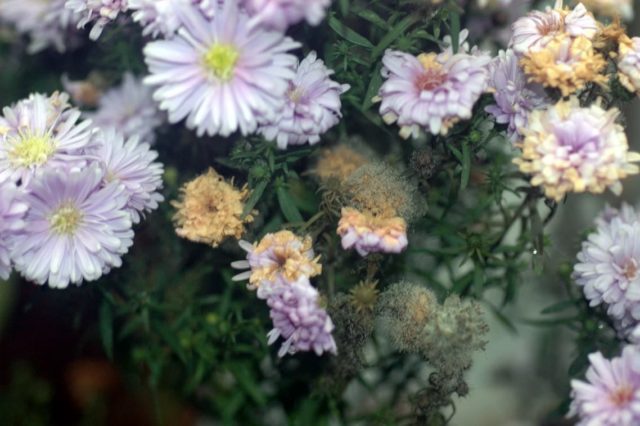
The treatment of shrubs from rot is carried out by irrigating a perennial with a 1% solution of Bordeaux liquid for 30 days with an interval of 10 days, and all affected parts are removed and burned
The main methods of prevention are competent care. The main reasons for the appearance of diseases are waterlogging of the soil, planting heather asters in the shade.
Conclusion
Aster heather is an unpretentious, but surprisingly beautiful perennial. It is characterized by late flowering, good frost resistance. Hybrids are used both for single plantings and for creating group compositions.

